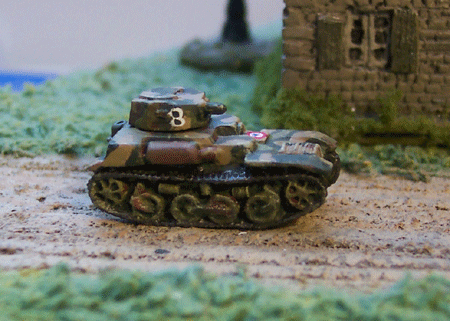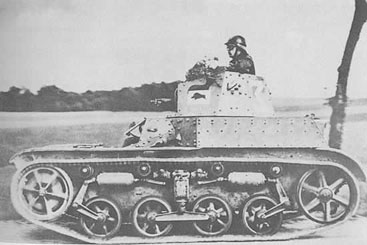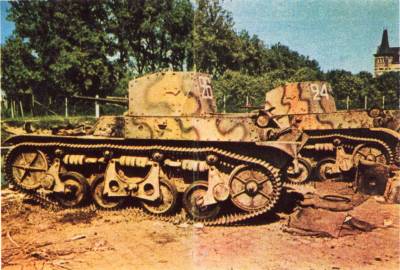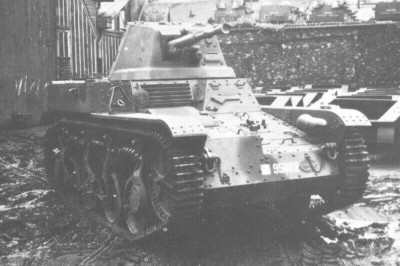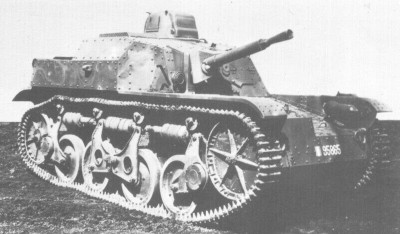|
AMR 33 and AMR 35DescriptionThe AMR (Auto-Mitrailleuse de Reconnaissance) was a light tank used by the cavalry for skirmishing and scouting. Despite its name, the AMR was not primarily a reconnaissance vehicle. Reconnaissance was the responsibility of the AMD (Automitrailleuse de Découverte) armoured cars such as the Panhard 178. The AMR was built in two basic models: the AMR 33 and AMR 35.
Development - AMR 33
In the early 1930's the French created a plan to motorise part of their army including the five existing cavalry divisions. This plan of January 1931 included a requirement for an AMR (Auto-Mitrailleuse de Reconnaissance) vehicle for the cavalry of 3 tons, armed with a light machine gun and having a range of 200 kilometres. Anticipating this requirement, Renault had already in November 1931 begun to design a tracteur léger de cavalerie type VM based on the existing Renault UE tractor. However this was rejected as being too cramped. Renault hastily designed a larger mode and presented it in March 1932. They received an order for five prototypes to be delivered in September which the cavalry hoped to use as a provisional platoon for the autumn manoeuvres. Renault experimented with the suspension, and although based on the Carden Loyd and Renault UE each was slightly different. They were judged to be agile, but also noisy, uncomfortable for the crew and lacking sufficient range. After the exercise they were sent back to Renault, who shortly afterwards submitted three for further testing in November and December 1932. These had sufficient speed, but a range of only half the required 200km and at 4.8 tons they exceeded the required 3 tons. To solve these problems it was decided to abandon the three ton weight limit and install larger fuel tanks and heavier armour. In April 1933 Renault submitted two new vehicles for testing. In March 1933 the Cavalry placed a preliminary order of 45 vehicles. On June 6th production was approved of the AMR Renault modèle 1933 and immediately followed by a second order for another 20 vehicles and then in the autumn for a final order of 50. The Renault factory identifier for the AMR 33 was Renault VM. The vehicles were delivered between June and September 1934. Even the original 5 prototypes were rebuilt as standard production vehicles. Three production vehicles were used as development vehicles for the AMR 35 so to compensate for this three more AMR 33's were built in 1935 for a total production run of 123. Development - AMR 35
Even before the AMR 33 was delivered, Renault started work on an improved AMR 35. The two main problems with the AMR 33 were the fragile suspension and the noisy engine. In February 1934 a new prototype was submitted for testing with a larger engine. Renault hoped that the whole production run of AMR 33s would be converted to this new engine but that was not allowed. Instead a new order for 92 of the new AMR 35 was placed. Additionally 8 command tanks, called AMR 35 ADF, were ordered with a larger superstructure replacing the turret. The Renault factory identifier for the AMR 35 ADF was Renault YS. It was becoming clear that the AMR 33 was a very unreliable tank: the suspension was simply too weak to withstand the force of cross-country driving. A complete redesign of the suspension was performed using that of the Renault R35 as the model. Due to the time required to redesign the suspension, the first AMR 35 was only delivered in April 1936. The Renault factory identifier for the AMR 35 was Renault ZT later the ZT1. It was decided that the AMR units needed some intrinsic anti-tank capability. To do this it was decided to up-gun some AMR 35s giving them a 13.2mm Hotchkiss heavy machine-gun or a 25mm anti-tank gun. The 13.2mm Hotchkiss heavy machine-gun, which could penetrate 20mm steel at 500m, was mounted in the existing production turret. Of the 167 ZT1 models built, 80 had the13.2mm machine-gun.
Two different version of the AMR 35 mounted the 25mm anti-tank gun:
With the advent of the ZT2 and ZT3 models, the original ZT became known as the ZT1. In 1936 two more orders followed. The first for 20 AMR 35's, five Renault ZT2 and five Renault ZT3. The second 55 AMR 35's, five Renault ZT2, five Renault ZT3 and five Renault YS. The total orders for AMR 35 amounted to 200 vehicles: 87 ZT1 with 7.5 MG, 80 ZT1 with 13.2mm HMG, 10 ZT2, 10 ZT3 and 13 YS. OperationThe tank had a crew of two: one driver to the left next to the engine and the tank commander/gunner behind him in the turret. The AMR had an AVIS-1 (Atelier de Vincennes) turret produced by Renault. This had a unique feature for a French tank turret of the day, a hatch in the top for observation. The AMC 35 was the only other production tank so equipped; other tanks were had a cupola with vision slits. While not providing protection like a cupola, the hatch gave the commander a much better view of the battlefield. Access to the tank was by means of large double hatch at the back of the hull. During the battle the 13.2 mm gun, despite its ability to penetrate 20mm steel at 500m, proved to be incapable of defeating even the German armored cars, its bullets being deflected by their sloped armour. In the Battle of France the AMR fared very badly being both poorly armed and armoured. The one main advantage of the AMR was its speed; it was the fastest French tank of its day and faster than all the German light tanks. However travelling at high speed cross-country played havoc with the poorly designed suspension which quickly wore out. During the campaign, more AMR's were lost to mechanical trouble than to enemy action. The AMR 35 ADF (Renault YS) was used as an artillery observation vehicle and fitted with advanced telemetric optics.
VarientsIn 1936 21 Renault ZT4's were ordered for the colonial troops to replace their obsolete Renault FT-17's. This order was later increased to 56. They were standard hulls but built without turrets; the old FT-17 turrets with Hotchkiss 8mm machine-guns were to be used on new hulls of the AMR 35. By the time France capitulated, 40 ZT4 hulls had been produced but none had turrets fitted. DeploymentIn the Battle of France 120 AMR 33's and 187 AMR 35's were available. These were used to equipped
It was planned to equip each AMR 35 troop with two 13.2mm HMG and three 7.5 MG vehicles. It was intended to give the BCP in each DCR a troop of 5 AMR but this was never realised. 10th May 1940When the Germans attacked the French army had:
Aditionally ten AMR 33 were in the colonies. What happened to the other vehicles produced, including the ten AMR 35 ZT2 is uncertain. Technical Data
| ||||||||||||||||||||||||||||||||||||||||||||||||||||||||||||||||||||||||||||||||||||||||||||||||||||||||||||||||||||||||||||||||||||||||||||||||||||||||||||||||||||


